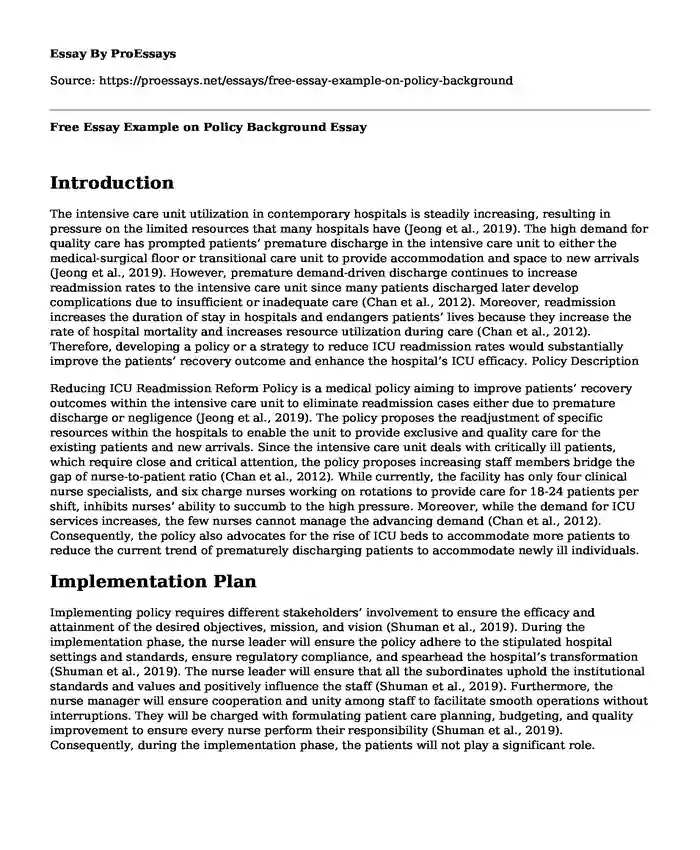Introduction
The intensive care unit utilization in contemporary hospitals is steadily increasing, resulting in pressure on the limited resources that many hospitals have (Jeong et al., 2019). The high demand for quality care has prompted patients’ premature discharge in the intensive care unit to either the medical-surgical floor or transitional care unit to provide accommodation and space to new arrivals (Jeong et al., 2019). However, premature demand-driven discharge continues to increase readmission rates to the intensive care unit since many patients discharged later develop complications due to insufficient or inadequate care (Chan et al., 2012). Moreover, readmission increases the duration of stay in hospitals and endangers patients’ lives because they increase the rate of hospital mortality and increases resource utilization during care (Chan et al., 2012). Therefore, developing a policy or a strategy to reduce ICU readmission rates would substantially improve the patients’ recovery outcome and enhance the hospital’s ICU efficacy. Policy Description
Reducing ICU Readmission Reform Policy is a medical policy aiming to improve patients’ recovery outcomes within the intensive care unit to eliminate readmission cases either due to premature discharge or negligence (Jeong et al., 2019). The policy proposes the readjustment of specific resources within the hospitals to enable the unit to provide exclusive and quality care for the existing patients and new arrivals. Since the intensive care unit deals with critically ill patients, which require close and critical attention, the policy proposes increasing staff members bridge the gap of nurse-to-patient ratio (Chan et al., 2012). While currently, the facility has only four clinical nurse specialists, and six charge nurses working on rotations to provide care for 18-24 patients per shift, inhibits nurses’ ability to succumb to the high pressure. Moreover, while the demand for ICU services increases, the few nurses cannot manage the advancing demand (Chan et al., 2012). Consequently, the policy also advocates for the rise of ICU beds to accommodate more patients to reduce the current trend of prematurely discharging patients to accommodate newly ill individuals.
Implementation Plan
Implementing policy requires different stakeholders’ involvement to ensure the efficacy and attainment of the desired objectives, mission, and vision (Shuman et al., 2019). During the implementation phase, the nurse leader will ensure the policy adhere to the stipulated hospital settings and standards, ensure regulatory compliance, and spearhead the hospital’s transformation (Shuman et al., 2019). The nurse leader will ensure that all the subordinates uphold the institutional standards and values and positively influence the staff (Shuman et al., 2019). Furthermore, the nurse manager will ensure cooperation and unity among staff to facilitate smooth operations without interruptions. They will be charged with formulating patient care planning, budgeting, and quality improvement to ensure every nurse perform their responsibility (Shuman et al., 2019). Consequently, during the implementation phase, the patients will not play a significant role.
Evaluation Plan
Implementing the policy will ensure fast and efficient admission of quality care for patients. For example, with more nurses, assessing the patient’s conditions, and responding to patients’ needs will become easy and efficient. Increasing the number of beds will enable the intensive care unit to accommodate more critically ill patients instead of prematurely discharging other patients to accommodate new ones. Therefore, the policy will help ensure proper recovery of patients before discharge from the ICU and eventually reduce the readmission rates due to poor care and demand-driven release.
Conclusion
Cultural factors, such as socio-economic trends, influence value formation, and policy implementation (Gopalkrishnan, 2018). As the policy aim at improving the healthcare outcome among patients, it must adhere to and respect the socio-cultural values, beliefs, and customs of patients (Gopalkrishnan, 2018). Since many patients are often unfamiliar or distrust some health care services, considering patients’ cultural beliefs and traditions is critical in decision-making during the implementation stage.
References
Chan, C. W., Farias, V. F., Bambos, N., & Escobar, G. J. (2012). Optimizing intensive care unit discharge decisions with patient readmissions. Operations research, 60(6), 1323-1341.
http://www.columbia.edu/~cc3179/ICU_2012.pdf
Gopalkrishnan, N. (2018). Cultural diversity and mental health: Considerations for policy and practice. Frontiers in public health, 6, 179.
https://www.frontiersin.org/articles/10.3389/fpubh.2018.00179/full
Jeong, B. H., Na, S. J., Lee, D. S., Chung, C. R., Suh, G. Y., & Jeon, K. (2019). Readmission and hospital mortality after ICU discharge of critically ill cancer patients. PloS one, 14(1),
https://journals.plos.org/plosone/article?id=10.1371/journal.pone.0211240
Shuman, C. J., Powers, K., BanaszakHoll, J., & Titler, M. G. (2019). Unit leadership and climates for evidencebased practice implementation in acute care: A crosssectional descriptive study. Journal of Nursing Scholarship, 51(1), 114-124.
https://sigmapubs.onlinelibrary.wiley.com/doi/full/10.1111/jnu.12452.
Cite this page
Free Essay Example on Policy Background. (2024, Jan 01). Retrieved from https://proessays.net/essays/free-essay-example-on-policy-background
If you are the original author of this essay and no longer wish to have it published on the ProEssays website, please click below to request its removal:
- Acromegaly: A Rare, Serious, Insidious, Chronic, but Treatable Disease - Essay Sample
- Essay Example on Nursing Educators: Skills & Competencies for Curriculum Design
- Essay Sample on Cultural Adaptation: How Puerto Rican Society Evolves
- Essay Sample on Exploring the Balance Between Capitalism & Socialism in The United States
- Essay Sample on Evidence-Based Practice: Integrating Clinical Expertise and Research Evidence
- Essay Sample on Prescription of Narcotic Drugs: Ethical & Legal Implications & Strategies
- Report Sample on Covid-19 and the New Leadership







